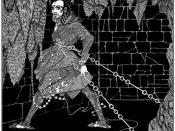One need not wonder any longer why Edgar Allen Poe was the master of terror after reading his short story "The Cask of Amontillado". Through the use of tension and ambiguity Poe has succeeded in creating suspense throughout this tale. Poe's writing gives an excellent example of how tension, imagery, and irony combine to create an overwhelming effect of terror.
The story begins with Montresor declaring his intention to seek revenge against Fortunato, "At length I would be avenged: this was a point definitely settled-but the very definitiveness with which it was resolved precluded the idea of risk. I must not only punish, but punish with impunity," leaves little doubt that he intends the revenge to be extremely severe, but even more importantly is his predetermination of not getting "caught in the act" so to speak. Upon the initial meeting and throughout the sequence of events, he is incredibly amiable, calling Fortunato "my friend" and declaring how pleased he is to see him.
Thus the tension begins to build. The more solicitous Montresor becomes, the greater the tension. His friendly greeting "my dear Fortuanto" magnifies the irony in "you are luckily met". Fortunato is anything other than lucky in meeting Montresor this night. Clearly Montresor's statement of intent to "make himself felt as such to him who has done the wrong," juxtaposed with the graciousness and eagerness with which he addresses Fortunato creates an atmosphere filled with tension.
Another masterful tool of suspense is the vagueness of the "thousand injuries" and the ultimate insult. If we knew the crime we might be able to anticipate the level of retribution, but because the wrongs are completely omitted we are unaware of what to expect. We cannot even guess at the level of revenge or offense based on our knowledge of...


